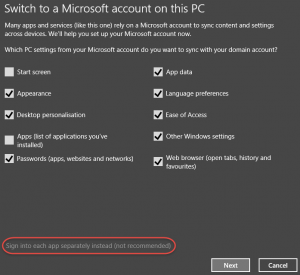Windows 8.1 and Microsoft Account: How to alienate people
Microsoft has been doing a lot of work recently to make amends with their customer base after the introduction of Windows 8. The first update (Windows 8.1) brought back the start button, the second update (Windows 8.1 Update 1) made the Metro interface (yes, “Metro” I am sticking with the name) more mouse and keyboard friendly, and they recently announced they will be bringing back the Start Menu in an upcoming update.
All the signs are pointing that Microsoft is listening to their customers and willing to provide them with a choice. Choice: The not-so-secret ingredient that makes a system competitive and flexible across different user bases and segments. The ingredient that Microsoft decided to leave out in Windows 8 for reasons nobody knows why (and I bet this includes people in Microsoft itself), which is as bad as a pasta dish with no sauce, or a paella without saffron.
All well when it ends well, right? Well, not quite. There is one particular “feature” that Microsoft has been silently pushing into Windows, making it more difficult to avoid with every update: The Microsoft Account (previously known as Microsoft Wallet, then Microsoft Passport, then .NET Passport, then Microsoft Passport Network, and most recently Windows Live ID). With Windows 8 Microsoft provided users with the choice to integrate their user account with a Microsoft Account, which allow users to sync their settings across multiple devices.
With Windows 8.1 however, this choice became the default option when installing Windows. Users would have to click a small link at the bottom of the set-up page to continue without syncing their computer account with their Microsoft Account. But that is not the end of it. Every time you try to sign into a Microsoft Account in a Metro Windows App, Windows will ask you to switch your computer account to a Microsoft Account. Again the option to ignore this is displayed at the bottom, with a “not recommended” note next to it.
So why not go with it? Why not accept this option? After all, synchronising your settings across devices sounds like a good idea, right?
The issues here are many. First of all, one has to trust such data with Microsoft. It does not matter if one uses Outlook.com or Office Web Apps, or any other Microsoft service. Such argument is a feeble-minded logical fallacy. Just because a user uses one Microsoft service does not mean the user will trust and accept another service by default.
Another issue is that many users would like to separate their work from their personal lives, without having to create another Microsoft Account. Sure that you can select what to sync with your Microsoft Account, but something you wish to keep private or something you wish to sync between your work and home PCs might overlap. This could happen by accident. What if you decide to sync your desktop background and then one day at home you change your background to something that is not suitable for your PC at work?
Also if you do sign-in with your Microsoft account, your account will now be named like your full name on your Microsoft Account. This can be infuriating if you use an alias for your local PC account. For example, John might be called John Michael Doe III on his Microsoft Account, but prefers to be called Johnny on his personal laptop. Also the pictured used for the account will be the same associated to the Microsoft Account. In other words, the use of Microsoft Account hinders the ability of users to customise their account locally.
Most importantly, the Microsoft Account associated with a local account will be the default account for every other app that uses a Microsoft Account. This can be quite infuriating, particularly if you have more than one Microsoft Account. In my case I have a my Microsoft Account which I use to all services that are associated to me directly, such as my Microsoft certifications, XBOX Live account and so forth. However the organisation I work for does provide me with access to certain Microsoft products and services such as MSDN, which is not associated to me but to the organisation itself (e.g.: If I decide to leave the company tomorrow, I should no longer have access to such Microsoft products and services). So in this case I do have to use multiple Microsoft Accounts during the day.
In this case, let’s consider both Microsoft Accounts (home and work) in a Venn diagram. There is a small overlapping between the two of them. This overlap is likely to shift from time to time, and this Microsoft Account integration does not make it any easier to manage both accounts.
Now there is another issue which is a fundamental one to me, with is the right of privacy and the right of consenting adults to do whatever they see fit in the privacy of their own home (providing no crime is being committed). Microsoft has a policy in their OneDrive terms which clearly states that users should not upload pictures containing “nudity of any sort, including full or partial human nudity, or nudity in nonhuman forms such as cartoons, fantasy art or manga”. If you decide to automatically sync your pictures with OneDrive, this means you now have Microsoft’s Big Brother in your computer. If you are a photographer and took pictures of a nude model, or even if you are an artist and you draw a nude picture, your account can be permanently suspended as soon as that picture gets into OneDrive and Microsoft finds it.
I already wrote about this issue in a previous blog post, though. So what has changed since then?
Today I tried to install the OneDrive desktop application on my Windows 8.1 (w/ Update 1) work laptop. However the install would never complete, no matter how much I tried. Upon investigation, I came across the fact that Windows 8.1 has the OneDrive app built-in into the OS. so there is no need to install the desktop application. Here is the gist, though:
To use the OneDrive built-in app, the app informs me that I must sign in into the computer using a Microsoft account. This is an issue for me because:
- I am using a corporate laptop; and
- don’t feel like it. And my fundamental and unalienable principle to choose not to do it should be enough reason why.
When I feel that Microsoft is done at antagonising its customers, they always surprise me with stuff like that. Bravo, Microsoft!
Blog Categories
Recent Posts
- My 12-Year-Old Just Bypassed Windows 11 Parental Controls—and It’s Worse Than You Think
- Microsoft Dynamics: Unable to load plug-in assembly
- SLOTH: A model about user’s unreasonable expectations of systems design
- Wii U Haxchi and CBHC: There is a better option
- Old Windows? No Microsoft Store for you!

.png)
.png)
.png)
.png)









 Logging you in...
Logging you in... Loading IntenseDebate Comments...
Loading IntenseDebate Comments...